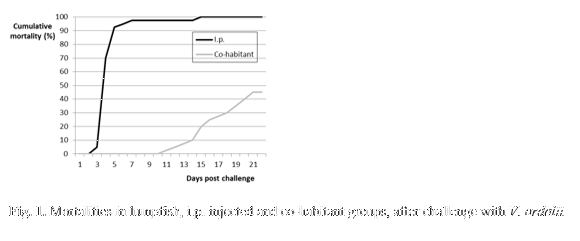SUSCEPTIBILITY OF LUMPFISH (CYCLOPTERUS LUMPUS) TO VIBRIO ORDALII AND INFECTIOUS PANCREATIC NECROSIS VIRUS (IPNV)
Introduction
The use of wrasse and lumpfish as cleaner fish to combat salmon lice in Atlantic salmon farming has become quite common. In recent years commercial production of Lumpfish (Cyclopterus lumpus) has increased in Norway. However, little is known about the susceptibility to diseases in this species and the potential for disease transmission from lumpfish to salmon and vice versa. Vibrio ordalii has been detected in several vibriosis outbreaks in farmed lumpfish in Norway in 2012 and 2013. This bacterium causes wounds and significant losses that may extend over time (Hjeltnes 2014). So far no viral diseases has been detected in lumpfish but IPNV, causative agent of IPN, has a wide host range and is a well-known problem in Atlantic salmon farming and may therefore represent a threat when lumpfish and salmon co-exist. The present study was undertaken to study the susceptibility of lumpfish to V. ordalii and IPNV.
Materials and methods
Lumpfish, mean weight 5 gr, were challenged in two trials at three different temperatures by bath or co-habitation with V. ordalii isolated from a vibriosis outbreak in lumpfish. A marine IPNV, originally isolated form halibut, was used in co-habitant challenge in one trial at two temperatures. Unchallenged controls were kept in a separate tank. Organ samples were harvested before start (t0) and weekly during the experiment and mortalities were registered. V. ordalii was re-isolated from head kidneys of dead fish after V. ordalii challenge, while IPNV was attempted isolated on CHSE-214 cells from head kidney and pancreas sampled at different time-point after infection.
Results
Preliminary results show that while no V. ordalii related mortalities were obtained after bath infection at 6 and 10oC, mortalities started 3 days post infection (dpi) in the intraperitoneally (i.p.) injected group and 11 dpi in the co-habitation group in the co-habitation experiment run at 15oC. Mortalities reached 100 % and 45 %, respectively (see figure 1). V. ordalii was re-isolated from dead fish in both the i.p. injected and co-habitant group. No mortalities were registered after bath challenges with IPNV at either 6 or 10oC. Samples from the challenged fish are now tested by titration in cell culture and by qPCR to see whether the fish has been infected by the virus.
Discussion and conclusion
This is the first report on disease related mortalities in farmed lumpfish under experimental conditions. Our preliminary results show that V.ordalii causes high mortalities in lumpfish after challenge and we demonstrate waterborne infection by this pathogen. No mortalities were obtained after bath challenge, but this could be temperature related, as these trials were performed at lower temperatures than the co-habitation trial. By nature, lumpfish are well adapted to temperatures below 10-12oC, while 15oC may be closer to their upper temperature limit, and is therefore more stressful to the fish. A bath infection represents a natural infection route, and is preferred in experimental challenge models for studying host-pathogen interactions. We will therefore perform new bath challenge experiments at higher temperatures to see if the outcome of infection is temperature-related. No mortalities were experienced in the IPNV co-habitation trials. Attempts are being done to clarify if the fish has gone through an infection without any macroscopic signs of disease. Lack of mortalities could demonstrate that lumpfish are not susceptible to IPNV, but challenge conditions and the viral strain used may well affect the outcome of the experiment. Earlier work has shown that this IPNV isolate from halibut is infective in Atlantic cod, establishing a long-lasting carrier condition (Jensen et al 2007).
References
Hjeltnes B (red) Fiskehelserapporten 2013. Oslo: Veterinærinstituttet; 2014.
Jensen, I. et al 2009. Susceptibility of Atlantic cod Gadus morhua juveniles to different routes of experimental challenge with infectious pancreatic necrosis virus (IPNV) Dis Aquat Org Vol. 85: 105-113, 2009
